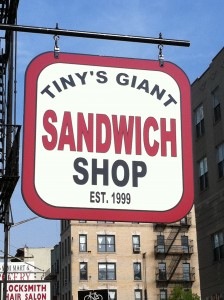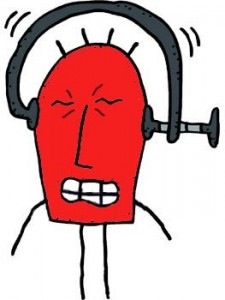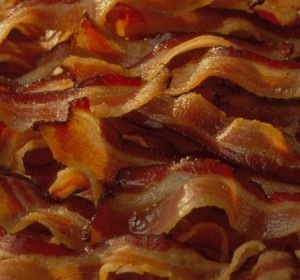 I guess one thing is for sure — you can get a sandwich — but I’m not quite certain whether it would be giant or tiny!
I guess one thing is for sure — you can get a sandwich — but I’m not quite certain whether it would be giant or tiny!
Takeout, Prepared Food, Junk Food
Want To Save 100 Calories?
Skip The Bacon
Want to save around 100 calories? That’s what’s in two medium slices of bacon.
Nix two slices of bacon on your bacon cheeseburger or two slices on your club sandwich or breakfast sandwich.
If you eat bacon five times a week that’s a pound lost in seven weeks and five pounds lost in 35 weeks just by subtracting those slices from what you normally eat. Of course, that’s assuming you don’t add an extra slice of cheese or a heaping spoonful of mayo!
Head Hunger
 Have you ever followed an argument with a friend – or maybe with your Mom – with a trip to the bakery or the closest candy store?
Have you ever followed an argument with a friend – or maybe with your Mom – with a trip to the bakery or the closest candy store?
You could already be stuffed to the gills. But, all you can think about is getting that cookie, or candy bar, or bag of pretzels and chowing down – even though you’re not hungry and may or may not actually enjoy what you’re eating.
There’s Real Hunger And There’s Head Hunger
Real hunger or physiological hunger is your body’s way of telling you that it’s time to eat food for nourishment. It’s when you have that empty, rumbling feeling in your stomach, a headache, maybe some lightheadedness. It usually occurs two to four hours after your last meal.
Head hunger or psychological hunger doesn’t have physical symptoms and can happen at any time. It can be triggered by emotional situations, habits — like watching TV, working on the computer or driving in the car — or by food cravings or as a form of procrastination. Whatever triggers your head hunger can make you think you’re hungry when you’re really not.
Emotions: Common Triggers For Eating
Emotions are common triggers for eating. Head hunger is emotional eating usually in response to gremlins like stress, sadness, loneliness, anger, fear, or boredom.
Head hunger also serves as a distraction – the eating it provokes can be a way to distract yourself from difficult situations, projects, and encounters.
The thing is, these feelings and situations are a part of life and eating won’t make them go away. Eating in response to head hunger often keeps you from figuring out what’s causing the feeling in the first place.
“I want chocolate” might really mean “I need comfort” or “I worked my tail off and I really need to be recognized for it.” Those trips back and forth to the fridge or the vending machine might be the ultimate form of procrastination – is there a project that needs to get done that you’re struggling with?
What To Do
Wouldn’t it be great if it was as simple as figuring out what’s causing your head hunger and dealing with it. The fact is, that’s the answer. Eating can’t really satisfy your emotional needs, and left unmet, those needs will trigger your head hunger over and over. So, you overeat, you mentally beat yourself up, you feel awful, and the whole process is triggered once again.
To break the pattern, first stop beating yourself up when you eat in response to head hunger — as opposed to eating because you’re starving and your stomach is growling like crazy. Devise a plan to figure out what caused you to eat in the first place. Try keeping a written record of what happened and how you felt before your head hunger took charge. Looking back at a series of entries might give you a clue. Once you get a handle on your triggers, come up with a plan to deal with them and make a “go-to” list of ways to reward, calm, comfort, and/or distract yourself without eating.
What’s Sweet, Shaped Like An Egg, And Doesn’t Come From A Chicken?
 Easter Eggs: The Confectionary Type
Easter Eggs: The Confectionary Type
They’re everywhere and at every price point. Some are piped with flowers and others are wrapped in foil. You find them in supermarkets, discount stores, and fancy candy stores.
Easter is the second ranked holiday for candy purchases in the US (just behind Halloween) and solid, hollow, and filled chocolate Easter eggs are some of the most popular choices of Easter candy.
Calories in Chocolate Easter Eggs
I don’t want to be a killjoy, but chocolate is a high calorie, high fat food.
Here’s the stats for some popular chocolate eggs:
- Hershey’s Cadbury Chocolate Crème Easter Egg: 1 egg (39g), 180 calories, 8g Fat (5g saturated), 25g Carbs, 2g Protein
- Hershey’s Cadbury Crème Egg, original milk chocolate with soft fondant crème center: 1 egg (39g), 170 calories, 6g fat (3.5g saturated), 28g Carbs, 2g Protein
- Hershey’s Cadbury Mini Egg: solid milk chocolate eggs with a crispy sugar shell: 12 eggs (40g), 200 calories, 9g fat(5g saturated), 28g carbs, 2g protein
- Hershey’s Milk Chocolate Eggs: 7 pieces, 200 Calories, 12g Fat (7 saturated), 24g Carbs, 3g Protein
- Dove Silky Smooth Milk Chocolate Eggs: 6 eggs, 240 Calories, 14g Fat (8g saturated), 26g Carbs, 3g Protein
- Dove Rich Dark Chocolate Eggs: 6 eggs (43g), 220 calories, 14g Fat (8 saturated), 26g carbs, 2g Protein
- Reese’s Milk Chocolate and Peanut Butter Eggs: 5 pieces (38g), 190 Calories, 12g Fat (6 saturated), 21g Carbs, 4g Protein
- M & M’s Milk Chocolate Speck-Tacular Eggs: 1/4 Cup (12 pieces), Calories: 210 Calories, 10g Fat (6 saturated), 29g Carbs, 2g Protein
- Solid Milk Chocolate Easter Bunny: 2.5 oz, Calories: average 370
But Isn’t Chocolate Good For Me?
The health benefits in chocolate come from cocoa and dark chocolate has a greater concentration than milk chocolate. White chocolate, without any cocoa in it, is not really chocolate. In a recent study, German scientists followed 19,357 people for at least 10 years and found that those who ate the most chocolate, (average 7.5 grams a day or .26 oz), had lower blood pressure and a 39% lower risk of having a heart attack or stroke than people who ate the smallest amount (1.7 grams or .06 oz a day).
Chocolate, especially dark chocolate, contains flavonols which have antioxidant qualities and other positive influences on your heart health. It can be heart healthy if it replaces an unhealthy, high calorie snack, but there is still no recommended amount for health benefits.
Just a heads-up: Those delicious, pastel wrapped chocolate Easter eggs are caloric and moderately high in fat, one-third of it the type of saturated fat that isn’t heart healthy. Extra ingredients like crème and caramel fillings can add lots of extra fat and calories.
Does Clean Eating Mean Making Sure You Wash Your Veggies?
 What Is Clean Eating?
What Is Clean Eating?
Clean eating is about wholesome and natural food – food that isn’t full of chemicals, preservatives, additives and isn’t processed and/or refined.
Clean eating is healthy eating. All of the whole, natural, unprocessed foods in a clean diet are chock full of vitamins, minerals, fiber, and other nutrition that will help you control your weight, blood pressure, blood sugar, and cholesterol, and other markers important for good health.
What To Do
To eat clean, the April 2011 edition of Environmental Nutrition lists seven basic behaviors:
- Eat fresh, uncomplicated, whole food – and choose it in its natural state.
- Eat smaller meals – perhaps three small meals and two snacks each day instead of behemoth portions.
- Eat good carbs — keep the healthy carbs like veggies, legumes, whole grains, and fruit in your life – and ditch the processed and refined ones like the “whites” (sugar, flour, rice).
- Incorporate healthy fats like the monounsaturated fat in olive oil and nuts and cut down on the saturated fats found in dairy and animal products and the trans fats in processed baked and fried foods.
- Eat high quality lean protein like fish, chicken, turkey, lean meat, and low or non-fat dairy.
- Make water your beverage of choice.
- Move your body.
By the way, you do need to wash your vegetables – and fruit. Wash them really well in plenty of plain water. No need for detergents or fancy vegetable washes.
